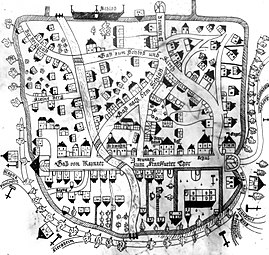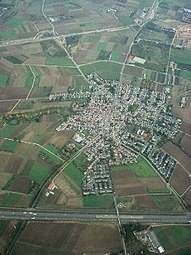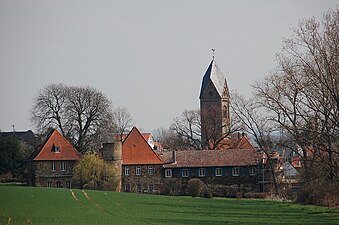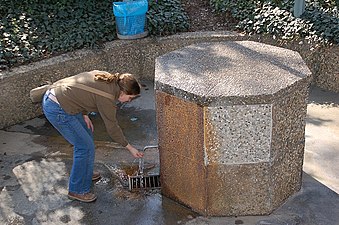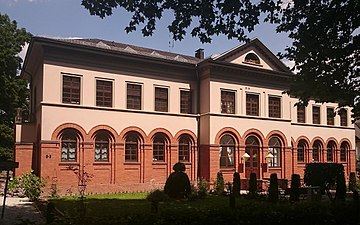Weilbach (Flörsheim)
|
Weilbach
City of Flörsheim am Main
|
|
|---|---|
| Coordinates: 50 ° 2 ′ 43 ″ N , 8 ° 26 ′ 6 ″ E | |
| Height : | 113 m above sea level NHN |
| Area : | 7.45 km² [LAGIS] |
| Residents : | 4007 (June 30, 2017) |
| Population density : | 538 inhabitants / km² |
| Incorporation : | December 31, 1971 |
| Postal code : | 65439 |
| Area code : | 06145 |
|
Center of the place
|
|
Weilbach is a district of Flörsheim am Main in the Main-Taunus district in southern Hesse .
geography
Geographical location
Weilbach is located on both sides of the Weilbach on the southern edge of the Main- Taunus foreland above the Lower Main plain with a view over the Rhine-Main area to the south and to the Voraunus and Hohen Taunus to the north. The place is in the acute angle formed by the A 66 and A 3 motorways southeast of the Wiesbaden junction , between Wiesbaden and Frankfurt am Main .
geology
The gravel and sands, which were mainly deposited by the Main during the Ice Age , were used economically for a long time, and fossil finds were also made. Some of the pit was later used as a garbage dump. The so-called Silbersee has been recultivated and a nature reserve with an adjoining nature school run by the Society for Recultivation of the Weilbacher Gravel Pit Landscape , a Hessian institution promoting nature conservation on site (such as the Bergstrasse Nature Conservation Center near Bensheim or the Hessen Nature Conservation Center in Wetzlar).
Weilbach, above the A 66, below the A 3 with the high-speed Cologne – Rhein / Main line
Weilbach in the Main-Taunus-Kreis , in the background the Taunus
history
The oldest mention in a deed of donation to the St. Jakob monastery in Mainz as Wilibach dates from 1112. Later, the name Niederweilbach was used to differentiate it from the former neighboring town of Oberweilbach . Weilbach was under the Mainz Elector since 1581 and belonged to the Archdiocese of Mainz . In 1803 Weilbach went to Nassau-Usingen and at the time of the Duchy of Nassau belonged to the Hochheim office . After the annexation by Prussia it was in 1867 the main circle later and the district Wiesbaden in the administrative district of Wiesbaden assigned.
Weilbach joined forces with the city of Flörsheim and the neighboring municipality of Wicker on December 31, 1971 in the run-up to the regional reform in Hesse . A local district was established for the Weilbach district and a local advisory board was elected.
Due to the economic development after the Second World War, especially due to the nearby industry in Frankfurt-Höchst , there was a strong population growth and a change in the livelihood of most of the residents , as in other towns in the Rhine-Main area .
badges and flags
The coat of arms and the flag were approved by the Hessian Ministry of the Interior on September 9, 1955.
| Blazon : "In the divided shield above in gold a growing black wolf, below in red a silver wheel." | |
Flag description: "In the red and white divided flag field, the Weilbach local coat of arms in such a way that the upper golden half of the coat of arms of the red flag line and the lower red half of the coat of arms of the white flag line rests on top."
Culture and sights
At the northwestern end of the Weilbach ( Hessian: the Weilbach) is the Weilbach Castle , which was built in the 12th to 13th centuries and was built by the knight family Erlenbach von Weilbach. At the beginning of the 17th century, it came into the possession of Johann Philipp von Wolff-Metternich and is still owned by the family today. Occasional public events have meanwhile made the castle better known.
The Catholic parish church Maria Himmelfahrt was built in 1875 according to plans by the church architect Grau in the neo-Romanesque style. It has the shape of a columned basilica with a 30 m long nave and a 32 m high church tower. In 1996/97 the exterior was renovated, and in 2000 the interior was redesigned.
Bad Weilbach
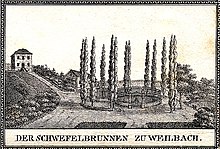
The Faulborn spring in Bad Weilbach is one of the numerous famous springs in Nassau . For a long time there was not just its own mineral water spring with a bottling plant. Medicinal water in the form of a sulfur spring also served as a basis for health-conscious guests in a spa house, a bathhouse and an inhalatorium. The neoclassical Kurhaus was built in 1838 on behalf of the Duke of Nassau. Guests at the facility included Johann Wolfgang von Goethe and the Rothschilds .
From 1911 the house was used as a rural school for women by the Reifensteiner Association for Economic Women's Schools in the Country , which Ida von Kortzfleisch had brought to life. In the former medical center, a colonial school was set up in addition to the classic Reifensteiner school , in which women were prepared for life in the German colonies.
From 1984 to 1986 the buildings that had fallen into disrepair, especially the Palais Weilbach, were converted into condominiums by Franz E. Schilke. The park is still an excursion destination in the region today. Bad Weilbach is a part of the Weilbach district.
literature
- Fresenius, R. (1856): Chemical investigations of the most important mineral waters of the Duchy of Nassau: V. The mineral spring to Weilbach . - Yearbooks of the Society for Natural History in the Duchy of Nassau 11: 145–178; Wiesbaden.
- Fresenius, R. (1860); Chemical investigations of the most important mineral waters of the Duchy of Nassau: VII. The new Natronquelle zu Weilbach . - Yearbooks of the Association for Natural History in the Duchy of Nassau: 15: 124-138; Wiesbaden.
- Hochheimer, W. (2003): Historical short tour through the history of Weilbach . - Flörsheim-Weilbach: self-published.
- Lixenfeld, H. (1988): Stories from the old Weilbach . - Flörsheim-Weilbach: self-published.
- Lixenfeld, H. (1990): Stories from the new Weilbach . - Flörsheim-Weilbach: self-published.
- Sandberger, F. (1851): The Nassau healing springs: Soden, Cronthal, Weilbach, Wiesbaden, Schlangenbad, Schwalbach and Ems . - Wiesbaden: Kreidel.
- Schilke, F. (1995): Castles as living spaces of the present .
- Schulz, A. (1852): Microscopic examination of the most important mineral springs in Nassau . - Yearbooks of the Association for Natural History in the Duchy of Nassau 8: II 49–89; Wiesbaden.
- Literature about Weilbach in the Hessian Bibliography
Web links
- Weilbach district. In: Internet presence. City of Flörsheim
- Weilbach, Main-Taunus-Kreis. Historical local dictionary for Hessen. (As of September 18, 2015). In: Landesgeschichtliches Informationssystem Hessen (LAGIS).
- Site created for the 900th anniversary of the site with information on the site's history
- State Office for Monument Preservation Hesse (Ed.): Complete system Weilbach In: DenkXweb, online edition of cultural monuments in Hesse
Individual evidence
- ↑ "Figures - Data - Facts" on the website of the city of Flörsheim am Main , accessed in August 2017.
- ↑ Weilbacher gravel pits & nature reserve house
- ^ Federal Statistical Office (ed.): Historical municipality directory for the Federal Republic of Germany. Name, border and key number changes in municipalities, counties and administrative districts from May 27, 1970 to December 31, 1982 . W. Kohlhammer GmbH, Stuttgart and Mainz 1983, ISBN 3-17-003263-1 , p. 370 .
- ↑ Approval of a coat of arms and a flag of the community Weilbach in the Main-Taunus-Kreis, administrative district Wiesbaden from 9 September 1955 . In: The Hessian Minister of the Interior (ed.): State Gazette for the State of Hesse. 1955 no. 39 , p. 977 , point 1031 ( online at the information system of the Hessian state parliament [PDF; 2.9 MB ]).
- ↑ Heike Lattka: Once only an imitation of the large bathrooms. In: Frankfurter Allgemeine Zeitung. October 20, 2011, page 59.
- ↑ Stadtportrait Weilbach floersheim-main.de


